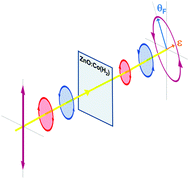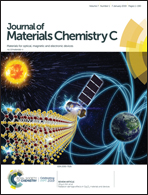Giant magneto-optical response in H+ irradiated Zn1−xCoxO thin films
Abstract
Remarkable improvements in the magneto-optical properties of Zn1−xCoxO thin films were achieved by post-growth hydrogen irradiation at temperatures of 400 °C. Hydrogen incorporation increases the magnetic circular dichroism signal resulting in large values of ellipticity and Faraday rotation at room temperature. The hysteretic behavior of the magneto-optical field dependent loops at different sub-bandgap wavelengths indicates an intrinsic ferromagnetic regime. A giant Faraday rotation of 3000 deg cm−1 was observed at 400 nm. Optical, structural and microstructural characterizations pointed out the Zn substitution by Co, ruling out the presence of noticeable Co-related secondary phases down to the nanoscale. The increased values of saturation magnetization, ellipticity and Faraday rotation have been explained based on an impurity band close to the conduction band minimum, which is induced by Co–VO (O vacancies) complexes. A phenomenological model founded on such an impurity band and electronic states induced by other Co-defect complexes in the ZnO energy gap allows a thoroughly novel, fine interpretation of the ellipticity spectra.



 Please wait while we load your content...
Please wait while we load your content...